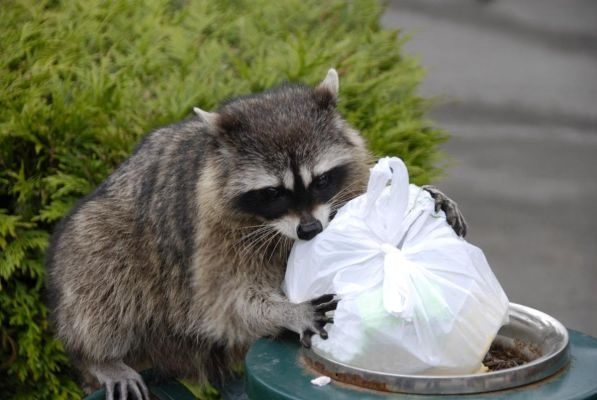
British people who own cats usually let them outdoors. Americans in the suburbs or in dense urban neighborhoods often keep our cats inside, and if one reason is rabies (the British have none), another might be the New World animals that compete with cats for curb and can space in our yards. There’s the opossum, our most famous marsupial, and the coyote, enabled by reforestation to show up these days in Northeast American yards; most picturesque, and most rascally, is the raccoon, or rather the array of roaming raccoons, since if you’ve seen one—and she’s seen you—you surely have not seen them all. That mask, children note, makes them look rather like eager bandits, but it also does a pretty bad job of concealing their identities: if you’ve got more than one raccoon prowling your garbage, their size, tails, and distinctive motions may let you strike through the mask and tell them apart.
The most important raccoon in literary history almost certainly died in the early 1970s; she, or he, was the McLean, Virginia critter who explored the garbage of the writer James Tiptree, Jr. (real name Alice Sheldon) thoroughly and charmingly enough to give her name to Sheldon’s second pseudonym, Raccoona Sheldon. Raccoona, not Tiptree, got the byline for some of Sheldon’s finest stories, among them the gruesome fable “The Screwfly Solution” (1977), in which men’s inability to separate sexuality from aggression brings about the end of the world. Raccoona, not Tiptree, also wrote the superbly double-edged story “Your Faces, O My Sisters! Your Faces Filled of Light!” (1976), which either envisions a world in which women roam from city to city, alone and unthreatened by men, or announces that such a world cannot be had in our time: the woman who dreams or hallucinates it gets killed.
Those stories should last, but the raccoon behind them is gone now. Raccoons in the wild tend to live just two or three years; in captivity, they can turn thirteen. It’s hard for any merely contemporary raccoon to measure up to that, and certainly the ones in my neighborhood don’t; they jump in and out of our outdoor cans, and do not stand for anything, least of all for writerly scrutiny, whether from me or from Ted Wilson, whose promise to review a raccoon is the proximate cause for the piece you are reading now.
The raccoons that frequent my parents’ place and sort through their garbage in northwest Washington, D.C., however, tell—or at least imply—a different story. If you go to confront them, they squint back at you for a fierce moment before running away. Cute and threatening at the same time, predictable yet alien, they may represent...
You have reached your article limit
Sign up for a digital subscription and continue reading all new issues, plus our entire archives, for just $1.50/month.
Already a subscriber? Sign in




